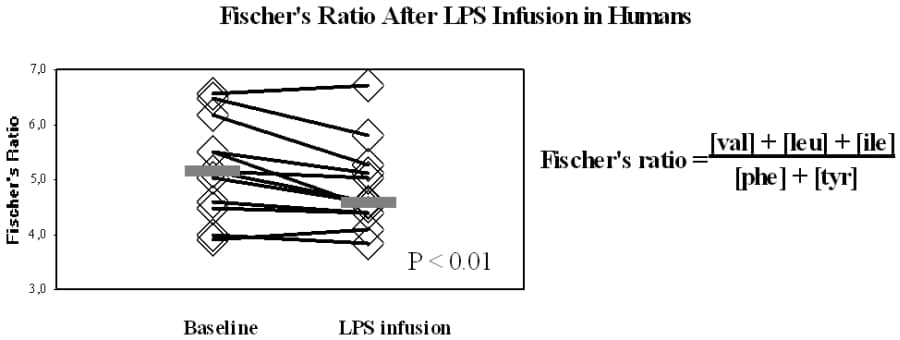Sepsis is frequently complicated by cerebral dysfunction, so-called sepsis-associated encephalopathy, which may be related to the presence of systemic inflammation. The mechanisms underlying this phenomenon remain unclear; however, a decrease in the plasma ratio between branched-chain and aromatic amino acids (Fischer’s ratio) has been speculated to play a role. This may cause a subsequent increase in the cerebral uptake of the aromatic amino acid phenylalanine, which can cause neurological symptoms. We therefore hypothesised that a decrease in Fischer’s ratio would occur along with an increased cerebral delivery and exchange of phenylalanine during a human-experimental model of systemic inflammation. Twelve healthy male volunteers aged 20-33 (median 26) years were enrolled in the study after ethical approval as well as oral and written informed consent. Volunteers underwent a four-hour intravenous infusion of Escherichia coli lipopolysaccharide (LPS) (total dose of 0.3 ng/kg). Global cerebral blood flow (CBF) measurements were performed by means of the Kety-Schmidt technique using inhaled nitrous oxide [1], and arterio-jugular venous differences of aromatic and branched-chain amino acids were determined before and one hour after the cessation of LPS infusion, by use of high-performance liquid chromatography (HPLC). Cerebral delivery and net exchange of amino acids were then calculated by multiplying CBF with the arterial concentrations and arterio-jugular venous differences of amino acids, respectively. An increase in the circulating levels of phenylalanine (P < 0.01, paired samples t-test) with unaltered levels of branched-chain amino acids occurred after LPS infusion, thus causing a decrease in Fischer’s ratio (P < 0.01, paired-samples t-test). CBF was unaltered after LPS infusion; however, there was an increase in the cerebral delivery of phenylalanine (P < 0.05, paired-samples t-test), whereas the cerebral net exchange of phenylalanine remained unchanged (P = 0.8, paired-samples t-test). In conclusion, Fischer’s ratio declines and the circulating levels and cerebral delivery of the aromatic amino acid phenylalanine increased after LPS infusion in humans. However, this was not associated with a change in the cerebral net exchange of phenylalanine.
University of Cambridge (2008) Proc Physiol Soc 11, C11
Oral Communications: Decreased Fischer’s ratio and increased cerebral delivery of phenylalanine after LPS infusion in healthy humans
R. M. Berg1, S. Taudorf1, D. M. Bailey2, C. Lundby3, F. S. Larsen4, B. K. Pedersen1, K. Møller1,5
1. Centre of Inflammation and Metabolism, University Hospital Rigshospitalet, Copenhagen, Denmark. 2. Neurovascular Research Laboratory, University of Glamorgan, South Wales, United Kingdom. 3. Copenhagen Muscle Research Centre, University of Copenhagen, Copenhagen, Denmark. 4. Department of Hepatology, University Hospital Rigshospitalet, Copenhagen, Denmark. 5. Departments of Cardiothoracic Anaesthesia and Intensive Care Unit 4131, University Hospital Rigshospitalet, Copenhagen, Denmark.
View other abstracts by:
Where applicable, experiments conform with Society ethical requirements.

